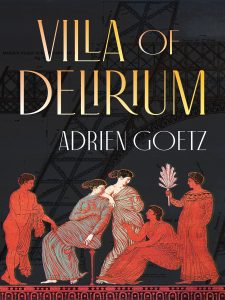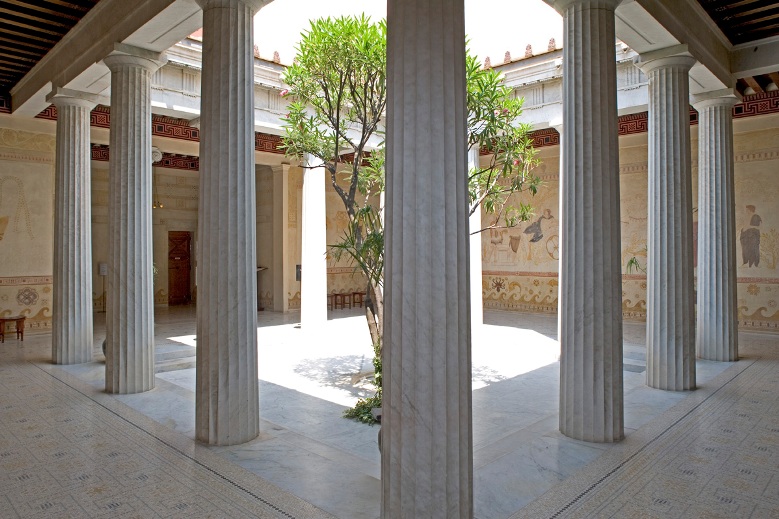
What’s ancient Greece doing on the French Riviera? (Beaulieu-sur-Mer, France; early to mid-20th century): A fantastical way to reflect on this fantastical historical novel would be to visit the real villa it’s based on: Villa Kérylos.
Short of that, you can take this 3D tour provided by the two-centuries-old Institut de France that owns the Villa, now a museum. You can further pique your interest reading this New York Times article, lavishly photographed. It led me to this sensuous and complex historically imagined novel written by what feels like the only person who could do it justice, Adrien Goetz, a French professor who teaches art history at the Sorbonne University in Paris. He’s also the editor of the Louvre Museum’s magazine, Grande Galerie. (The Louvre, the world’s largest museum, recently digitized their entire 480,000 piece collection online for free.) Goetz also writes for the French newspaper, Figaro. Turns out he’s also an expert on ancient Greece, telling us in A Few Historical Clarifications and Acknowledgements – few as in a dozen packed pages – that he was introduced to this ancient civilization at an early age by an uncle.
Kérylos is the Greek word for halcyon. In the aptly titled first chapter, The Halcyon Terrace, Goetz defines it in poetic and poignant terms: “The halcyon swoops over the waves; it is the bird of sadness, that bird that weeps in poetry.” The novel inspires many interpretations, poetic and poignant certainly. The overarching theme is the Villa’s exotic and eccentric mystique, although it fits the grand scale and grandeur of the French Riviera.

An unnamed narrator recounts this inventive, fictionalized tale soon after Gustave Eiffel’s landmark Paris Tower opened (Villa Eiffel neighbored Villa Kérylos). Spanning half-a-century, it ends around the time Grace Kelly became the Princess of Monaco in 1956. Which means it takes us through a reawakening to Picasso’s Cubist style, the Belle Époque, and the Nazi’s ransacking of the Villa during WWII as the owner, Théodore Reinach, and his family were Jewish.
Théodore Reinach was an archaeologist obsessed with Greece and making a discovery, a scholar on many other topics, who along with French architect Emmanuel Pontremoli designed and built this “blindingly” white villa perched high up on the edge of the Mediterranean Sea in a small village near Cap Ferrat, peninsula of millionaires.
Théodore was a member of the Institut de France. The museum hosts yearly conferences, which the author has participated in, speaking volumes as to how much there’s to explore and how much Goetz incorporated into his novel.
The narrator says Théodore was “more famous than a movie star.” Then why has no one written a biography on scholarly Théodore? Goetz surely could.
Expect many references to go over your head, as they did mine. And yet, you can’t put this book down. Goetz’s prose captivates. Soak up as much as you can, as I did. There’s still plenty to fascinate, absorb, and sense. Even if you’re not interested in ancient Greece, like I felt, Goetz wants us to appreciate this classical culture’s numerous, lasting contributions to society and language.
That’s why he starts off with this epigraph quoted from Théodore Reinach, explaining why we should care about ancient Greece:
“The Greeks discovered glory, they discovered beauty, and they brought to this discovery such jubilation, such an overabundance of life, that a sense of youthful contagion can still be felt even after the passage of three or four thousand years.”
In Théodore’s eyes, his Greek palace was a symbol of beauty, simplicity, and elegance. The reader will decide if it’s a spectacular feat of genius or madness? Decadence or outrageousness?
Our wistful, astonished, and forlorn narrator recounts this story in his seventies looking back on his youth, the “master of Kérylos,” culture and history with remarkable detail from his teenage years to the end of his twenties when he “watched this white and ocher house being built, lived here, worked here, fell in love here.” Tutored in “Archaic Greek” by Théodore too. His emotions run the gamut from awe of a brilliant man, idyllic contentment, and to an “absurd labyrinth that now seems grotesque to me.” After he left it, the narrator became a well-known Cubist painter and friends with George Braque, the other founder of this abstract art movement.
Théodore was attracted to the narrator’s youthfulness and friendliness, his Corsican Greek roots, and drawing skills taught to him by Eiffel, whose home he’d grown up in as the son of Eiffel’s cook.
“I still have a set of keys to the house,” the narrator begins. Abandoned at the time, he lets himself inside unnoticed to record fifty years of the Villa’s existence before it’s forgotten. The author got permission to write parts of the novel here, so he knows his way around the way the narrator “knew every room.” Which means he knows the names of every room, each named in Greek, listed at the back of the book. Even the dogs bore Greek names. The library overflowed with books on ancient Greece. The narrator’s memories and musings published as this novel.
Besides Théodore, the focus, his brothers Joseph and Salomon also lived here. All three famous in their own right. Why, then, is this family first becoming known to us?
Two mysteries drove the narrator to document the past. The primary one was to find an “extraordinary object” that belongs to him, hidden from most everyone, but the narrator knows the truth about it. Desperate to find it, assuming the Nazis didn’t get to it first, he searches everywhere taking us through the Villa, its courtyard and rooms that dredge up the pain of not solving the mystery of the disappearance of his first love, Ariadne, a watercolorist and “young Greek woman of my dreams.” Hired by Pontremoli, along with her husband, to paint the Villa from all its perspectives.

Renaming this pantheon to Greece Villa of Delirium fits the narrator’s mood when he fled delirious with unrequited love. His sadness comes from the fact that he couldn’t have her for keeps, despite now being a married man with children and grandchildren.
A few words about Joseph and Salomon. Joseph was a politician deeply engaged in the scandalous, anti-Semitic Dreyfus Affair. Salomon was director of the National Museum of Antiquities. In the Dictionary of Art Historians, you’ll see his extensive art and archaeology pursuits.
Théodore’s wife, Fanny, fancied the theater. Léon, their son, became a famous musician and composer. (Oikos, the music room.) Fanny was related to the fabulously wealthy Rothschilds, whose eye-popping Villa Ephrussi and gardens are another neighbor, now also a museum.
You’ll be introduced to new vocabularies steeped in Greek architectural, archaeological, and mythological worlds. An English word makes an impression: graphomaniac. Translated it means an obsessive impulse to write, which the three brothers did profusely.
A word about Natasha Lehrer. An award-winning translator, she pursued translation years after a career as an editor and journalist. In 2015, she wisely perceived a greater need for trans-national conversation.
The Villa was “proof that one could travel back in time.” Goetz has done a wildly superb job of letting us time travel.
Lorraine